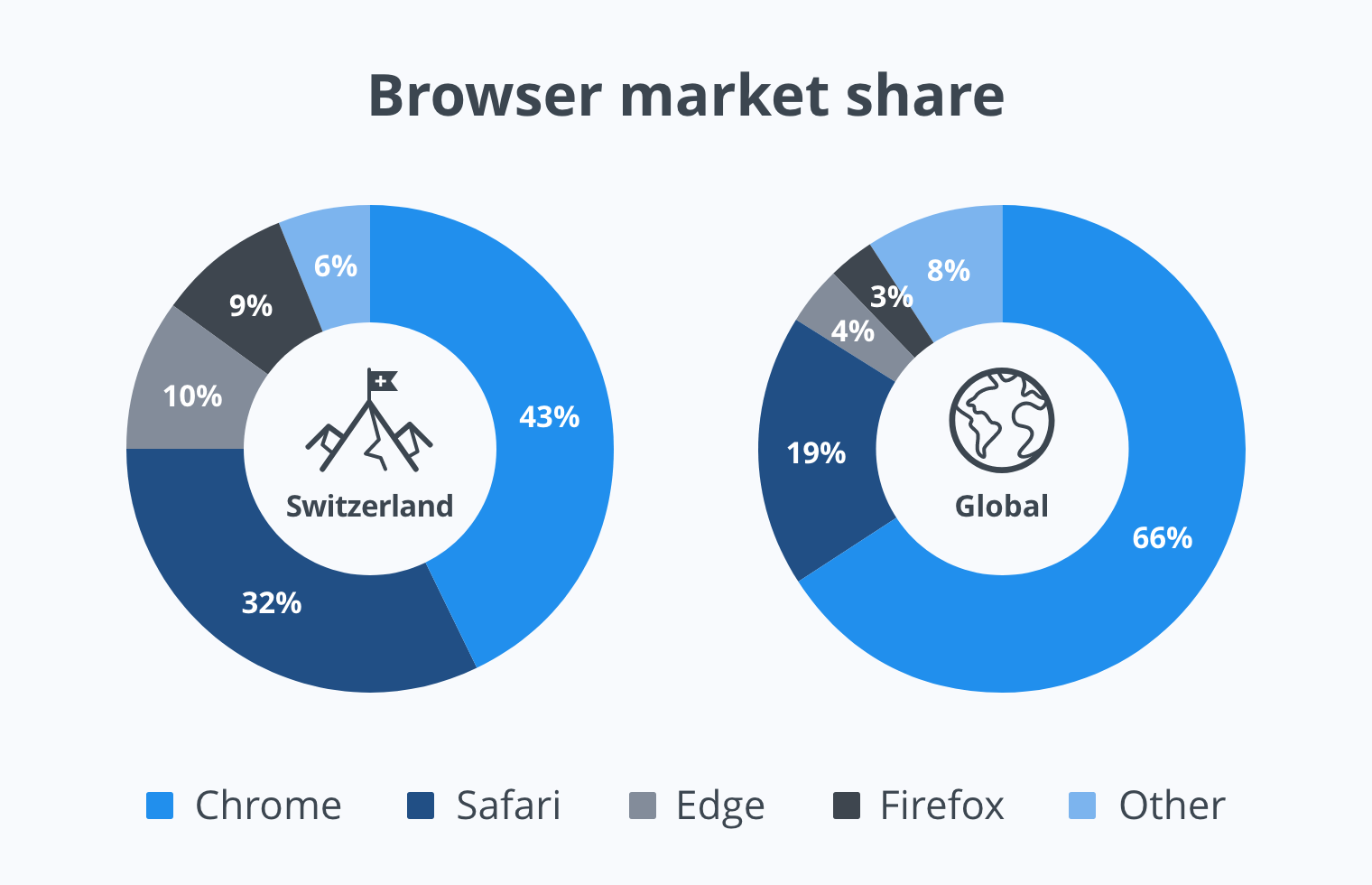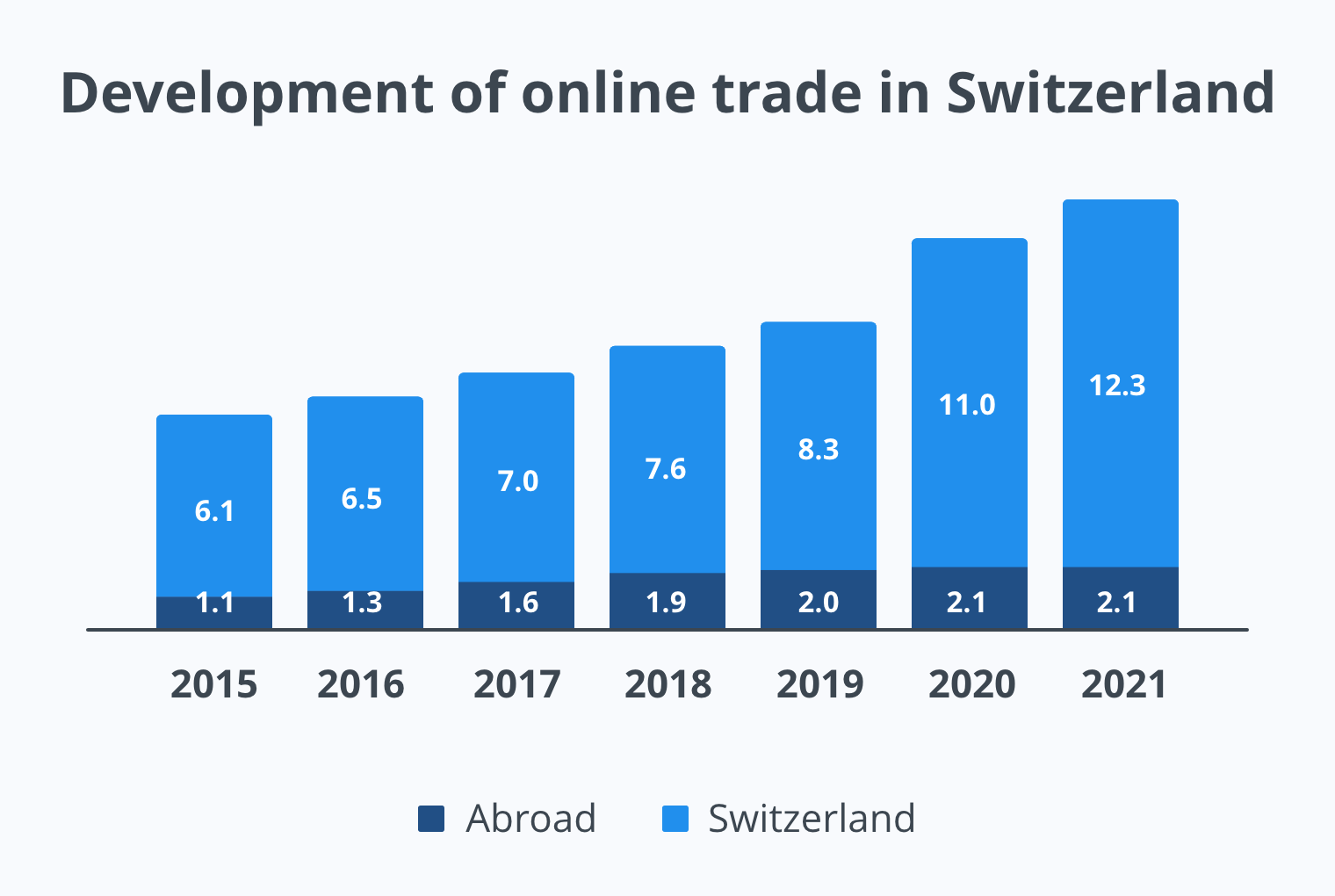Life without the internet is basically unimaginable for anyone anymore. And regardless of whether you’re a digital native or retiree, practically everyone in Switzerland uses the internet. The latest figures from the Federal Statistical Office show that last year, more than 95% of the Swiss population between the ages of 15 and 88 used the internet at least once. Meanwhile, 87.7% of Swiss people connected to the internet every day in 2021, an impressive increase of 2.7% compared to 2019.
With ever-improving network coverage and devices becoming smarter, it’s no surprise that sports broadcasts and the latest blockbusters can be streamed in even the most remote locations. The perceived omnipresence of the World Wide Web also means that internet services are being used not only nationwide but also across all age demographics. While over 90% of under-45s surf the web several times a day, 76% of 65- to 74-year-olds and 53% of 75-year-olds and over-75-year-olds use the internet every day.
Smartphones make up a significant proportion of the choice of medium for web access. According to StatCounter as of June 2022, a total of 42.05% of all internet page views in Switzerland are from mobile phones. For tablets, the figure is 2.6%. It is interesting to compare this with the figures for global page views: while smartphones account for more than 59% of page views worldwide, well ahead of desktop views at around 38% (the level of tablets globally is similar to Switzerland), Switzerland continues to receive the highest number of views from desktop devices (55.34%).
Champions, upstarts and the forgotten
On the World Wide Web, of course, you’ll find a wide variety of web browsers. According to StatCounter, the undisputed number one browser is Google Chrome, with a market share of 42.99% in Switzerland (as of June 2022). Apple’s second-placed Safari browser also holds a substantial share of local internet usage (32.27%). From a global perspective, Google Chrome’s supremacy is even more apparent: according to StatCounter, Chrome’s global market share stood at 65.87% as of June 2022. Safari ranks second in the world with 18.61%.

In terms of search engines, according to Statista, unsurprisingly Google is miles ahead of runner-up Bing at 91.66%. Only 4.62% of all Swiss searches were made via the Microsoft service in the past year. The two alternative and increasingly popular search engines DuckDuckGo and Ecosia hold 1.35% and 1.14% of the market share, respectively. Yahoo!’s search engine holds very little weight in Switzerland today, with a market share of just 0.83%.
By the way, if you’re wondering what happened to the once-popular AltaVista search engine, after the turn of the millennium, it lost more and more weight in the shadow of Google and was finally taken over by the company Overture in 2003, which in turn was acquired by Yahoo! just months later.
Google and WordPress at the forefront
In the ranking of websites that are visited by the majority of Swiss citizens (as of June 2022), tech giant Google also sits at the very top. According to a survey by similarweb, the domain google.com, with a traffic share of 15.32%, is far ahead of youtube.com (5.51%) – another Google service. Incidentally, the first .ch domain not owned by the Silicon Valley company is blick.ch. The daily newspaper’s website comes in sixth place with 1.29% of total traffic.
Speaking of Swiss domains, according to the registry operator SWITCH, a total of 2,494,888 domain names with .ch extensions were registered as of July 15, 2022. By way of comparison, at the beginning of 2009, there were just half as many. For the top-level domain .li in Liechtenstein, 69,577 .li domains were registered as of July 15, 2022 – almost twice as many as the principality’s population.
Most website operators use established CMS (content management systems) to manage the content on Switzerland’s many websites. According to an analysis by Statista in June 2021, 60.6% of Swiss websites were managed using WordPress. The first runner-up, TYPO3, is therefore far behind at 24.5%. Drupal and Joomla! share third place with 8.5% each. Comparison with global Statista statistics shows that WordPress is also a clear global leader at 43%.
The fact that WordPress is the undisputed favorite in terms of content management for companies and individuals is also illustrated by Hostpoint’s hosting figures. In addition to more than a million domains, the provider based in Rapperswil-Jona manages more than 300,000 websites, which in turn accounts for more than 100,000 WordPress installations. This makes Hostpoint one of the leading WordPress service providers in the Swiss market.
Online shopping and selling
E-commerce has been a billion-dollar business since long before the coronavirus crisis. But the pandemic has certainly not dampened the pace of growth. On the contrary, according to HANDELSVERBAND.swiss, Swiss online consumption amounted to CHF 14.4 billion in 2021. Compared to the previous year, this represents an increase of a whopping 9.9%.
The pandemic is also at least partly responsible for the change in customer behavior when buying online. In 2021, the number of shoppers using a smartphone app skyrocketed (from 14 to 34%). At the same time, only 57% of credit cards were used for online shopping last year (compared to 66% in 2019). Around 60,000 people (>1%) used cryptocurrencies, such as bitcoin, to pay for online purchases.
To the delight of the local e-commerce industry, the Swiss prefer to buy from online shops in Switzerland. Last year, the HANDELSVERBAND.swiss recorded sales of more than CHF 12.3 billion via Swiss online retailers. Only around CHF 2.1 billion was purchased from non-Swiss shops.

According to a survey by the consulting firm Carpathia, zalando.ch currently leads the ranking of online retailers with the highest turnover in the Swiss market. The fashion shop generated sales of more than CHF 1.4 billion in 2021, overtaking electronics retailer digitec.ch, which is in second place with around CHF 1.1 billion. The first non-Swiss shop is amazon.de, ranked third with around CHF 840 million.
Ultimately, it’s all about security
The ubiquity of the internet does, however, has its pitfalls in Switzerland as well. As a result, the issue of internet security is becoming increasingly more important. Personal data must be protected, payments must be processed smoothly and the transfer of files must be as secure as possible. Therefore, the issue of security for carefree surfing should not be underestimated. New technologies promise many possibilities, but unfortunately all too often make users forget about security.
Figures from the National Cyber Security Centre (NCSC) show a clear upward trend in cybercrime reports. In 2021, the NCSC recorded a total of 21,714 reports of cyber incidents. This is more than twice as many as in 2020. This trend is unlikely to change in the current year. At over 52%, fraud accounts for the largest proportion. However, Phishing cases are anything but rare, too. In the first half of 2021 alone, the NCSC recorded 2,439 phishing reports, five times more than the same period in the previous year.
In the interest of its customers and its own infrastructure, Hostpoint takes security very seriously. The infrastructure is continuously checked and optimized for potential vulnerabilities. The systems boast a high level of protection against DDoS attacks, and with well over 300,000 .ch DNSSEC-signed domains, the flow of information on the Swiss internet is made much more secure.























































